Most of us have probably wished, at some point, that our backyards (or front yards, for that matter) had a bit more privacy. Whether you have overly friendly neighbors or a yard with street frontage, a visual barrier can give both peace of mind and the freedom to enjoy your yard without having to worry about your outfit first!
On the other hand, despite what Robert Frost says, a big, imposing privacy fence isn’t the most neighborly structure to set up, and isn’t especially nice to look at — for you or passersby. That’s probably why many homeowners opt for a natural screen, composed of shrubs or small trees. It’s a great way to keep out prying eyes while giving them something to enjoy in place of your patio furniture.
The main drawback of a shrub screen is speed — or rather, lack of it. Usually, when you want privacy, you want it right away — not ten years from now. If you’re a new homeowner, it can seem like a plank fence is your only option if you want to enjoy your privacy before you retire…
Luckily, there’s really no need to compromise aesthetics for speed, or vice versa (at least not too much). Today’s homeowners have an amazing range of choices for fast-growing shrubs, both native and exotic, that will give you the charming yet effective “green screen” you’re dreaming of in less time than you might think!
Below, you’ll find 15 of the very best of these, along with some valuable tips on choosing, planting, and caring for your own fast-growing privacy screen.
Key Takeaways
- The best shrubs for screens and hedges, regardless of their growth rate, have a few things in common: they’re evergreen, have dense foliage, and can be easily pruned. All of the plants on this list share these traits — but note that many of the hardwood species (i.e., not pines or other conifers) are vulnerable to frost at the northern edge of their range, and will drop their leaves in a hard freeze.
- When it comes to growth rates, a “fast-growing” shrub or tree is generally one that grows more than two feet per year. A few of the plants on this list top out at two feet per year, which is more “medium-fast” — but absolute growth rate isn’t the only thing to consider.
- Growth rates depend a lot on the age of the shrub. They’re usually averaged over a period of ten or twenty years, but sometimes are just the maximum growth rate — which might only last for a few years at most. (After all, a tree that could maintain a growth rate of 5 feet per year would be fifty feet tall in only ten years — it’s hard to think of any tree that actually grows like this.)
- It also depends to some extent on the cultural conditions in your garden. Most shrubs will only achieve their advertised growth rates in full sun, with plenty of water and fertilizer; drought, shade, and low fertility will all result in slower growth.
- Additionally, remember that in horticulture, like in everything else, you don’t get something for nothing. Really fast-growing shrubs and trees come with plenty of trade offs: they generally don’t live very long, both because of natural limits to their longevity and susceptibility to pests and diseases. You can’t do much about plant senescence (i.e., old age), but you can — and should — make sure to establish good growing conditions to maximize your hedge’s longevity.
- The first thing to do is to maintain good air circulation, both above and below ground. Belowground, that means good drainage: most of the plants on this list are exceptionally intolerant of heavy soils, and will quickly succumb to root rot if the roots are allowed to stay wet. Aboveground, air circulation is a function of proper spacing.
- Resist the temptation to crowd your shrubs together for a denser screen, because it won’t do you much good if your plants fall victim to fungal infections. Allow your hedge to fill in naturally — and even then, try to make sure there is space between individual plants to allow for airflow through judicious pruning.
- On the subject of pruning: make sure you know what your particular species will need to maintain a good shape. Some of the species on this list are pretty close to “plant it and forget it” shrubs, at least as far as shape and size; others will grow into three-story monsters if left untended. There’s also a wide range of best practices for pruning different species depending on their particular growth traits: for example, some species only flower from new growth, which means you can spoil a whole season of blooms by pruning at the wrong time of year.
- One consideration that can make a big difference in your privacy screen is diversity. Rather than plant a dozen individuals of the same species, mix two or three (or more) species — and even different ages. That way, the likelihood is much lower that a hard freeze, pathogen, or other garden disaster will kill all your plants. It can also make for an exceptionally attractive and interesting screen, much more than a bland wall of identical shrubs!
- Finally, give some serious thought to planting native species. Native plants are becoming increasingly easy to find in garden stores, for good reason: they’ve been carefully crafted by millennia of evolution to be successful in your particular area. And it hopefully goes without saying by now that there’s no need to compromise aesthetics for hardiness: many of our toughest native shrubs, like Yaupon holly and cherry laurel, are not just similar to, but dead ringers for, common commercial shrubs like boxwood and English laurel.
15 Fast Growing Shrubs for an Instant Hedge
1. Thuja, Arborvitae (Thuja occidentialis)
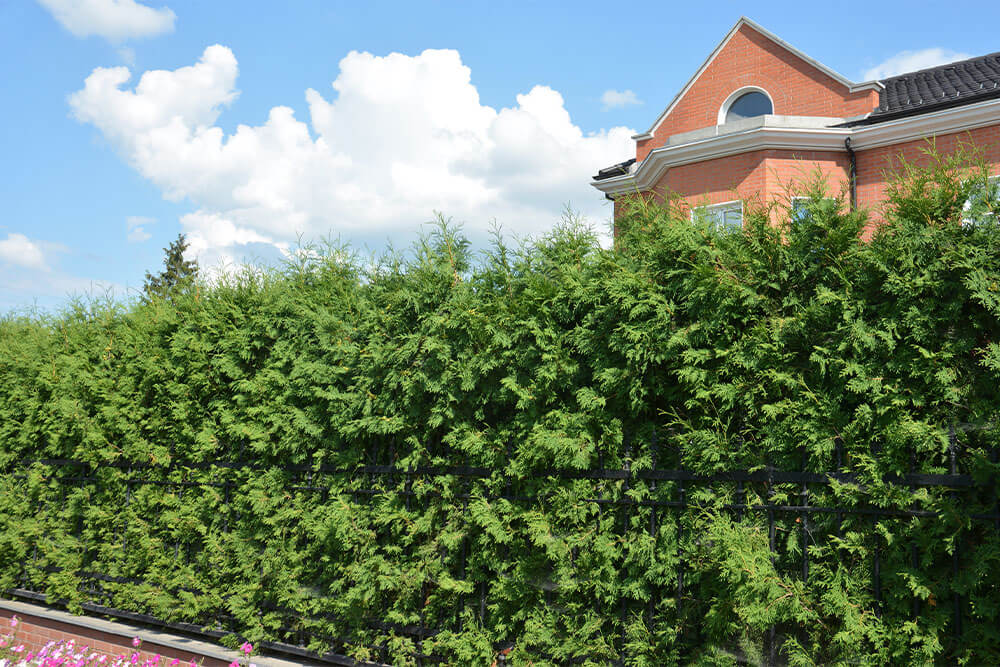
Thuja is a tough, low-maintenance, and extraordinarily fast-growing conifer native to North America that has become one of our most popular and widely planted trees.
Its attractive evergreen foliage and naturally upright, columnar habit are perfect for hedges, while its drought tolerance and impressive hardiness (zone 3 to 9) makes it suitable for almost any location in the country. The hybrid ‘Green Giant’ is slightly less hardy (to zone 5), but even faster growing, putting on 3 feet of growth per year in good soils!
2. Boxwood (Buxus sempervirens)
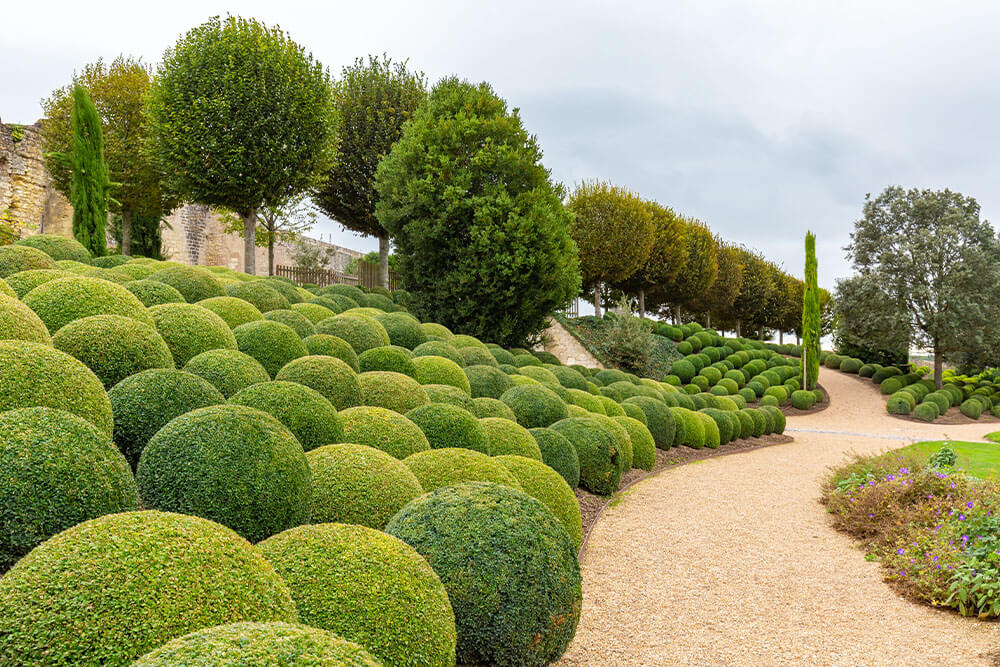
Boxwood is a classic hedge plant for a reason: its dense, evergreen foliage provides year-round privacy, and it can be pruned into almost any shape you like. If you’ve ever seen a topiary hedge, you’ve probably seen boxwood, as it’s one of the most popular hedge plants in the world. A native of the dry Mediterranean, this plant does best in mild climates (zones 5 to 8), in moist but well-drained soils.
In humid climates, regular pruning is necessary to maintain air circulation and prevent leaf spotting. Fortunately, one of boxwood’s best qualities is its flexibility and ease of pruning, so whether you’re going for “hedge maze formal” or “clean casual,” don’t be afraid to snip away!
3. Bayberry, Wax Myrtle (Myrica cerifera)
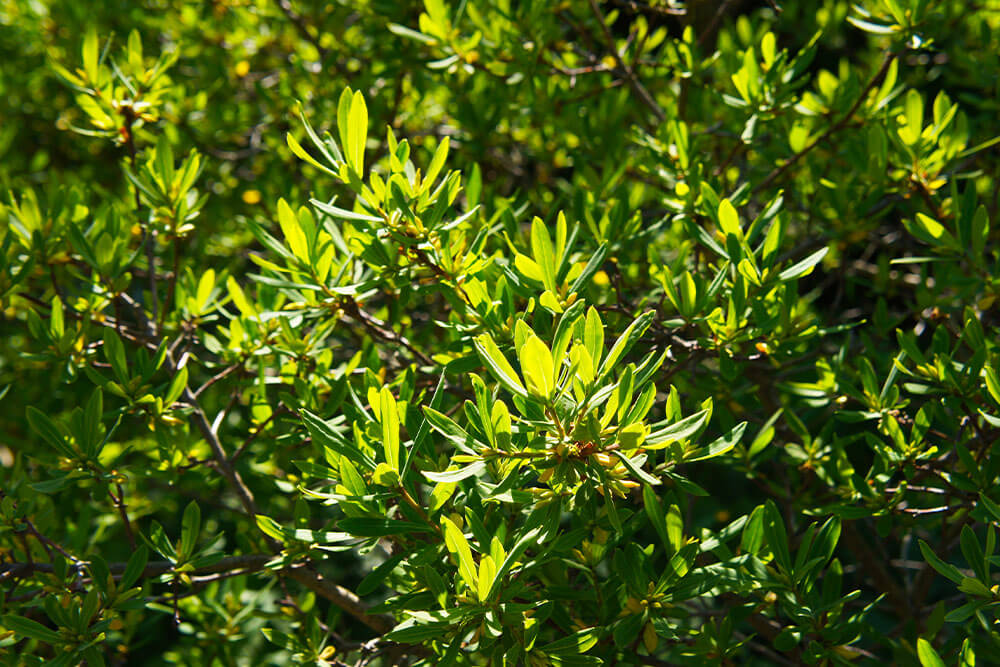
With a growth rate of 3 to 5 feet per year, bayberry (or southern bayberry) is one of the fastest-growing hedge plants around, whether native or non-native — but fast growth is far from the only reason to plant one (or several) of these attractive evergreen natives. It’s an extraordinarily adaptable plant, tolerating salt, heat, urban pollution, and poor soil with ease.
About the only thing wax myrtle doesn’t tolerate is extreme cold, and it’s only suitable for planting south of zone 8. Luckily, the closely related northern bayberry (Myrica pennsylvanica) has all the southern bayberry’s good qualities, but is hardy to an impressive zone 2. West Coast gardeners should look at the California bayberry – said to be the best native hedge plant on the Pacific Coast.
4. Pittosporum, Mock Orange (Pittosporum tobira)
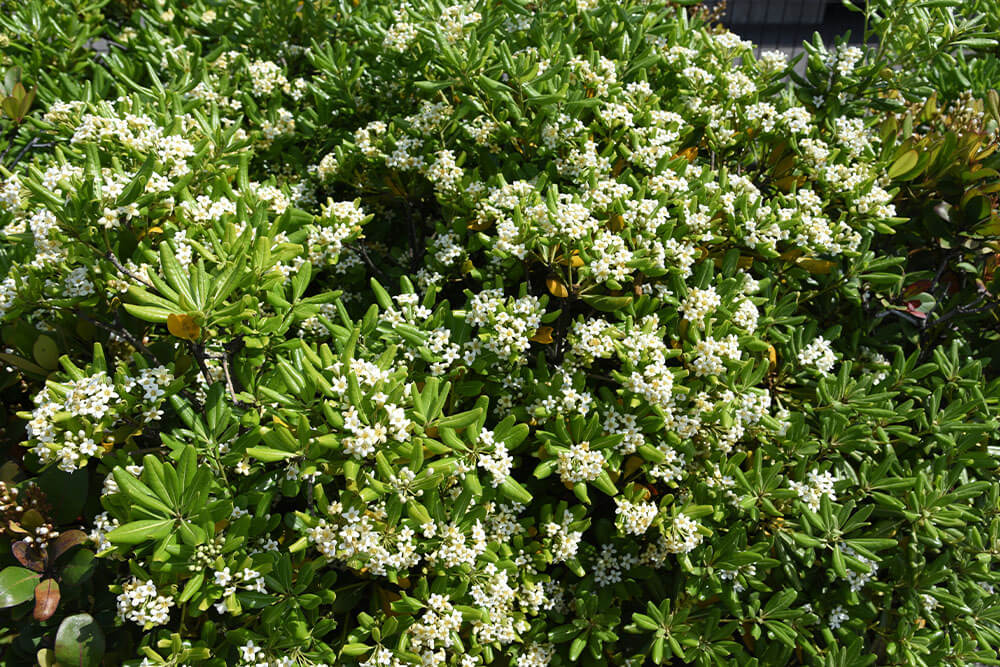
Pittosporums are adaptable and fast-growing evergreen shrubs that maintain year-round elegance, but truly shine in spring. That’s when they bloom, in prolific clusters of white, sweetly-scented flowers that are irresistible to humans and pollinators alike.
Despite its lush foliage and flowers, it’s a surprisingly hardy plant, as well as a vigorous one: taller varieties can put on three feet of growth per year, and can easily reach fifteen feet high in a few years! Unfortunately, pittosporums aren’t especially cold-tolerant: they’re only hardy between zones 8 and 11, making them best suited for hot and humid gardens.
5. Yaupon Holly (Ilex vomitoria)
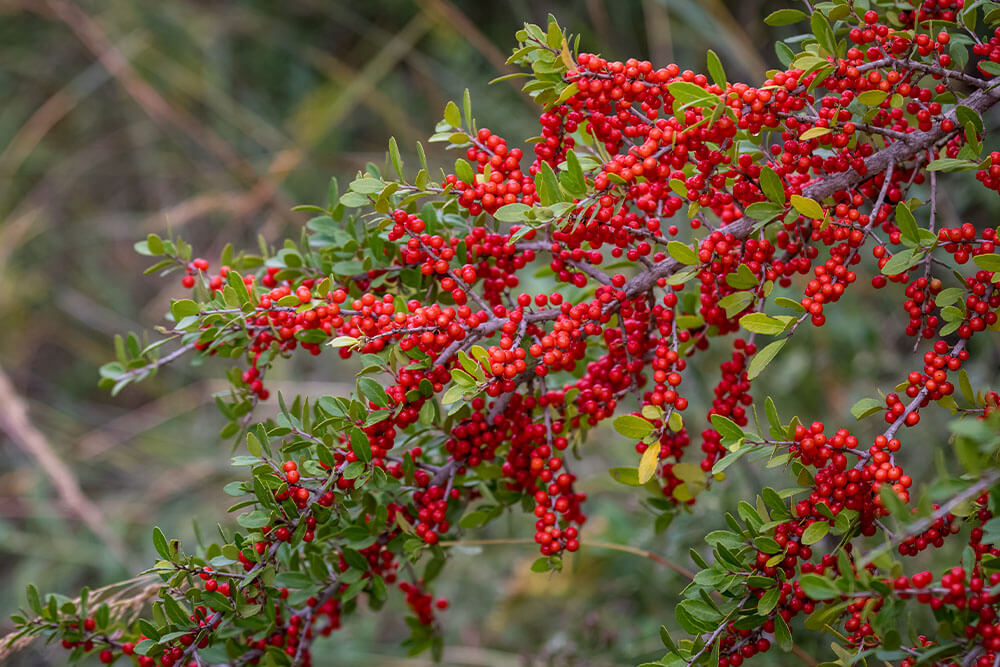
In climates too hot or too humid for more traditional hedge shrubs like boxwood, the native Yaupon holly is an ideal alternative. Its evergreen foliage actually looks remarkably like boxwood’s, and while it’s not as dense, is well-suited for privacy screens. Yaupon Holly may even have the edge when it comes to aesthetics, putting out attractive red berries in the winter that will remind you of its better-known European cousin, English holly (Ilex aquifolium).
Yaupon holly is hardy between zones 7 and 9, and needs to be pruned if it’s planted as a hedge, as it will become loose and almost tree-like if left to itself. However, a number of recent commercial cultivars maximize fruit production while keeping pruning to a minimum.
6. English Holly (Ilex aquifolium)
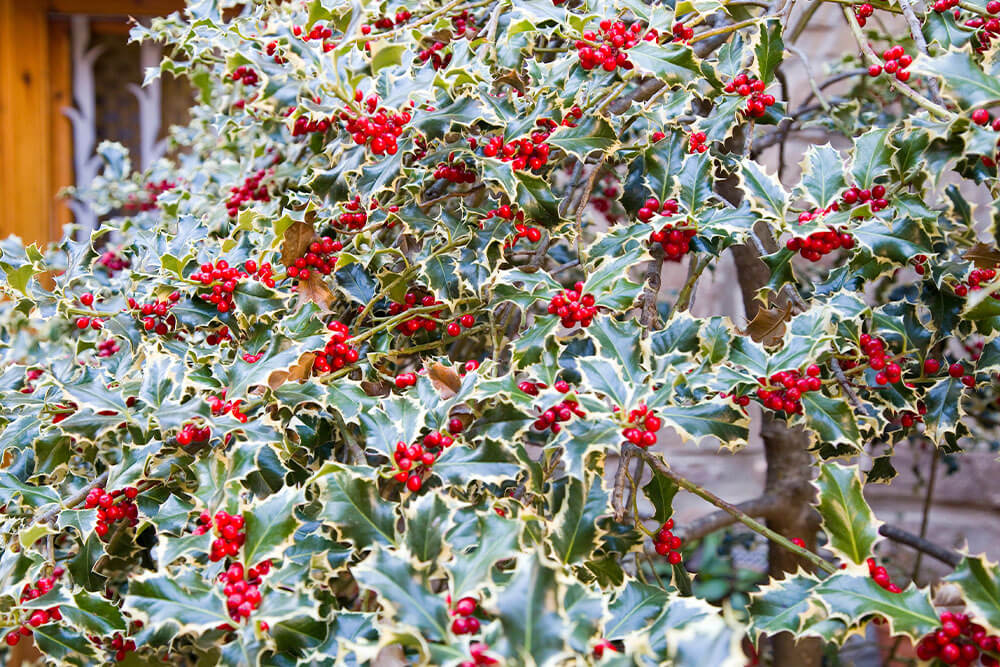
English holly is a classic and elegant shrub for privacy hedges, boasting attractive, evergreen foliage and red berries that persist throughout the winter. It dislikes both hot summers and cold winters, and is only reliably hardy between zones 7 and 9, but within this range it’s a vigorous and low-maintenance shrub that can occasionally reach impressive heights (25 feet or more).
As a result of its popularity, there are hundreds of varieties and cultivars available that sport beautifully variegated and multicolored foliage – not to mention dwarf varieties, which are perfect for hedges! One thing to bear in mind if you’re hoping for a bountiful crop of berries: hollies are dioecious, meaning that pollen-producing flowers and fruit-producing flowers are borne on separate plants, so you’ll need at least one male plant to get berries.
7. ‘Nellie R. Stevens’ Holly (Ilex x ‘Nellie R. Stevens’)
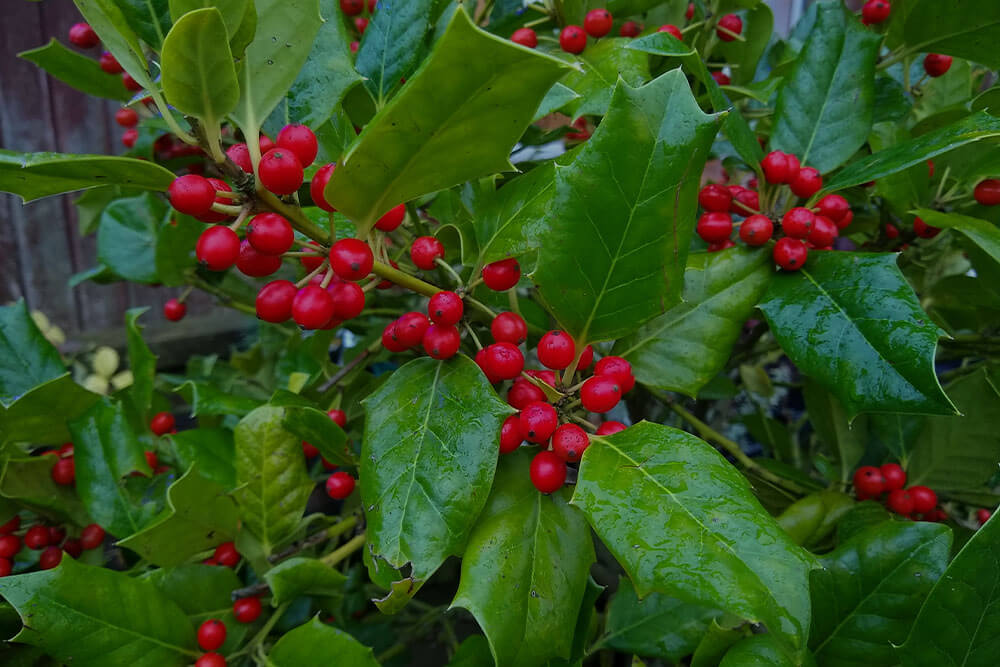
‘Nellie R. Stevens’ is a hybrid of the English and Chinese holly (I. cornuta), popular with gardeners in the South for its improved drought and heat tolerance. It’s also a bit more cold-hardy than either of its parents, and can be grown as far north as zone 6.
Like many hybrids, ‘Nellie R. Stevens’ is also extremely vigorous, putting on as much as three feet of growth per year! As if this weren’t enough, ‘Nellie R. Stevens’ hollies can (though they don’t always) produce berries even without a pollen-producing plant!
8. Oleander (Nerium oleander)
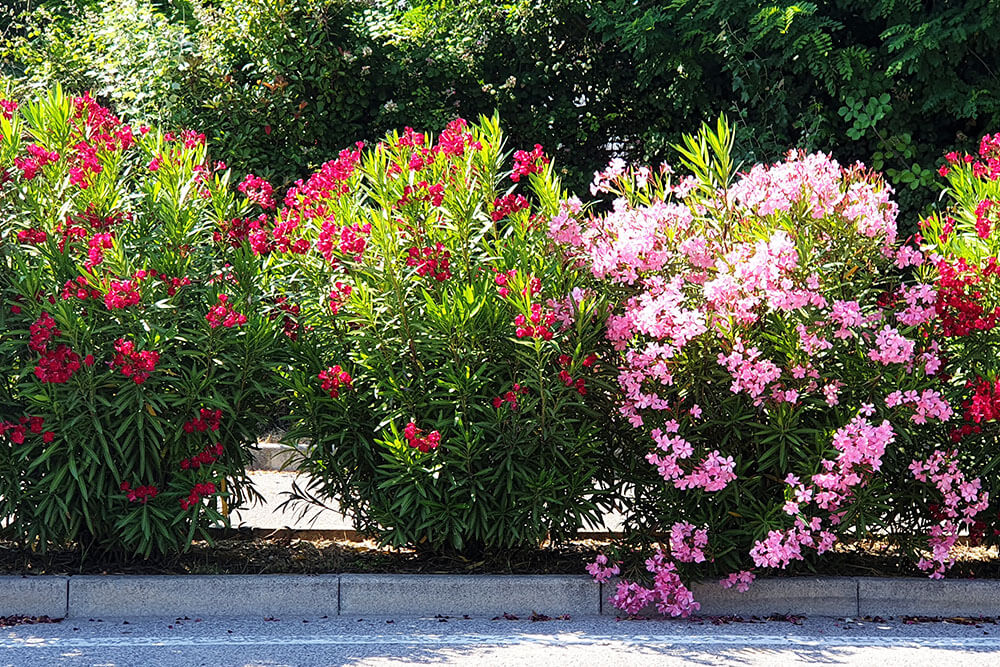
Oleander is an uncommonly beautiful shrub, with dramatic sword-like foliage that’s evergreen between zones 8 and 10, and perennial – but only semi-evergreen or deciduous – in zone 7. Its rapid growth and loose, multi-stemmed habit make it an ideal screen or privacy shrub, and one that boasts large flowers each spring, which come in a range of colors from red and purple to bright yellow.
That said, one thing all gardeners should know before planting oleanders,is that all parts of the plant are highly toxic. (Even the sap can cause dermatitis if it gets on your skin.) For this reason, it’s probably not a good choice for homes with small children or curious pets.
9. Eastern Red Cedar (Juniperus virginiana)
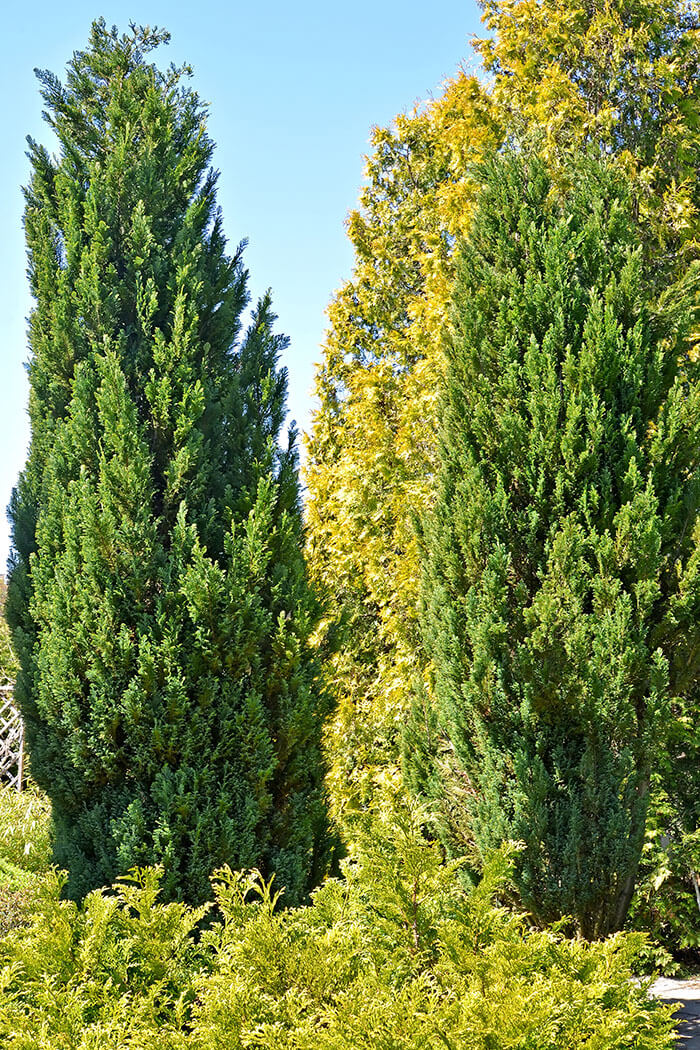
Eastern red cedar is not really a cedar but a species of juniper, native to the eastern half of the country. It’s an adaptable, low maintenance small tree that tolerates drought better than any other conifer in its range — which, spanning zones 2 through 9, covers pretty much the entire country! Eastern red cedar’s dense foliage is ideal for screens and hedges, as is its fast growth rate of 1-2 feet per year.
In the wild, its shape is quite variable, from leggy and untidy to an almost picture-perfect “Christmas tree” shape. Commercial cultivars like ‘Taylor’ and ‘Skyrocket’ maintain a clean, upright growth habit without pruning. One very important thing to remember with Eastern red cedar (or any juniper) is pollen: many people are highly allergic to it. Make sure you only buy “female” (i.e., seed-bearing) trees, or you might end up causing an outbreak of “cedar fever” in your neighborhood!
10. Leyland Cypress (Cupressus x leylandii)
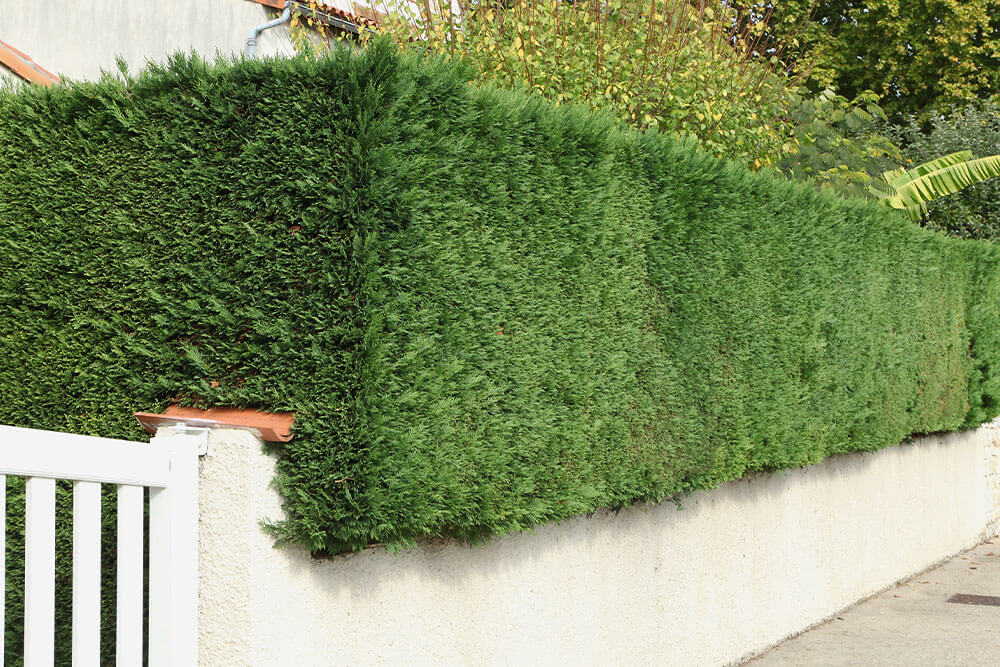
Leyland cypress is a hybrid of two native conifers, the Nootka and Monterey cypress. Such hybrids are often more robust and faster-growing than either parent, and this is certainly true of the Leyland, which can reach nearly 50 feet tall in only 15 years! In practice, few specimens ever get this tall, but dwarf cultivars are also available that are more suitable for gardeners who don’t like pruning.
Leyland cypresses are also amazingly adaptable plants, tolerant of salt, poor soils, and drought. Like a number of other cypresses, the Leyland is vulnerable to some fairly serious diseases, especially when grown in places with high humidity or heavy soil, so this tree isn’t suitable for the Southeast – if you’re looking for a conifer that will handle hot, muggy summers, try the eastern red cedar.
11. English Laurel (Prunus laurocerasus)
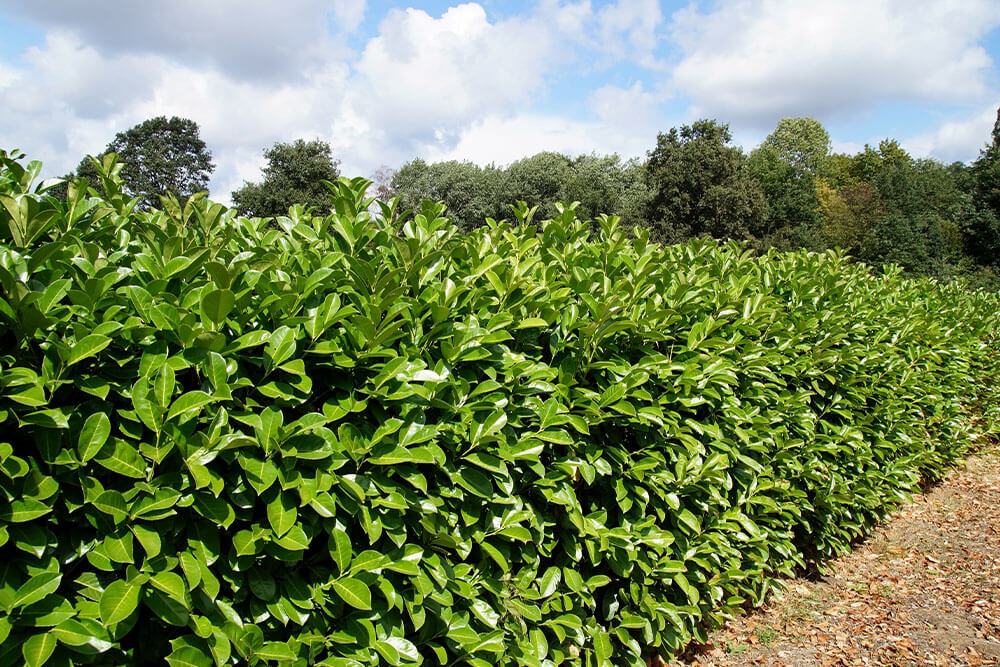
English laurel is sometimes called cherry laurel, but it is not to be confused with the closely-related native cherry laurel (P. caroliniana, below). Hardy between zones 6 and 8, it’s exceedingly popular in the landscape trade both for its fast growth rate — up to two feet per year — and its profuse, fragrant flowers, which bloom equally well in full sun and shade.
Its evergreen foliage makes it perfect for hedges, but unfortunately it can grow a bit too energetically in some parts of the country, where it has become an invasive species. Gardeners in these regions are advised to plant the native cherry laurel instead.
12. Cherry Laurel (Prunus caroliniana)
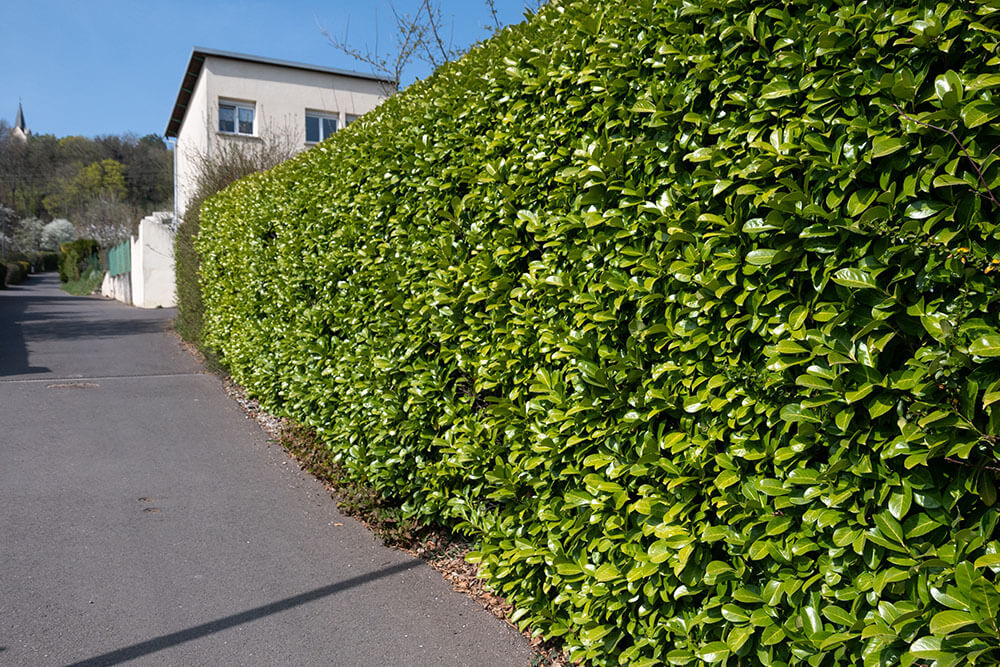
Our native cherry laurel can’t compete with English laurel for flowers, but if you’re looking for a low-maintenance, fast-growing hedge, it’s actually the better choice: with a growth rate of 3 feet per year, it’s one of the fastest-growing shrubs around, and it’s close enough in appearance to English laurel — and bay laurel, for that matter — that it can be used for the same applications.
As for maintenance, it’s next to nil: between zones 7 and 10, it tolerates a wide range of conditions, from drought to shade to salt. In fact, under ideal growing conditions it can become somewhat weedy, though technically not invasive, so monitor your hedge to make sure it doesn’t get out of hand.
13. Red Tip Photinia (Photinia x fraseri)
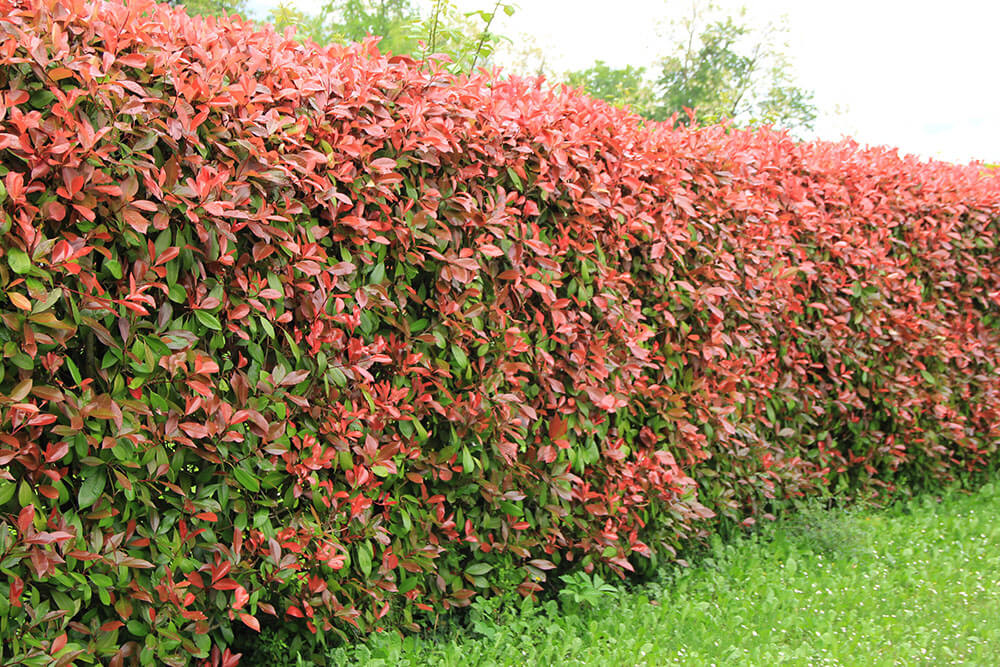
Red tip photinia is an easygoing, easy-growing hybrid of two commonly planted species: Chinese and Japanese photinia (P. serratifolia and glabra, respectively). It’s a large flowering shrub with attractive evergreen foliage – with a twist: new leaves are bright red, fading to a rich, deep green. Its white blooms are equally lovely, though only to look at: they are described as having an “unpleasant” aroma.
Red tip photinia’s growth rate – 2 to 3 feet per year – is one of the highest of any species of photinia, and gives plenty of leeway for pruning – which is as well, because judicious pruning is necessary not only to maintain the shape of the plant, but to provide air circulation and prevent diseases. Red tip photinia is hardy between zones 6 and 10, but should be protected from hard freezes in the northern edge of its range, and pruned to maintain air circulation in humid environments.
14. Golden Privet (Ligustrum ‘Vicaryi’)
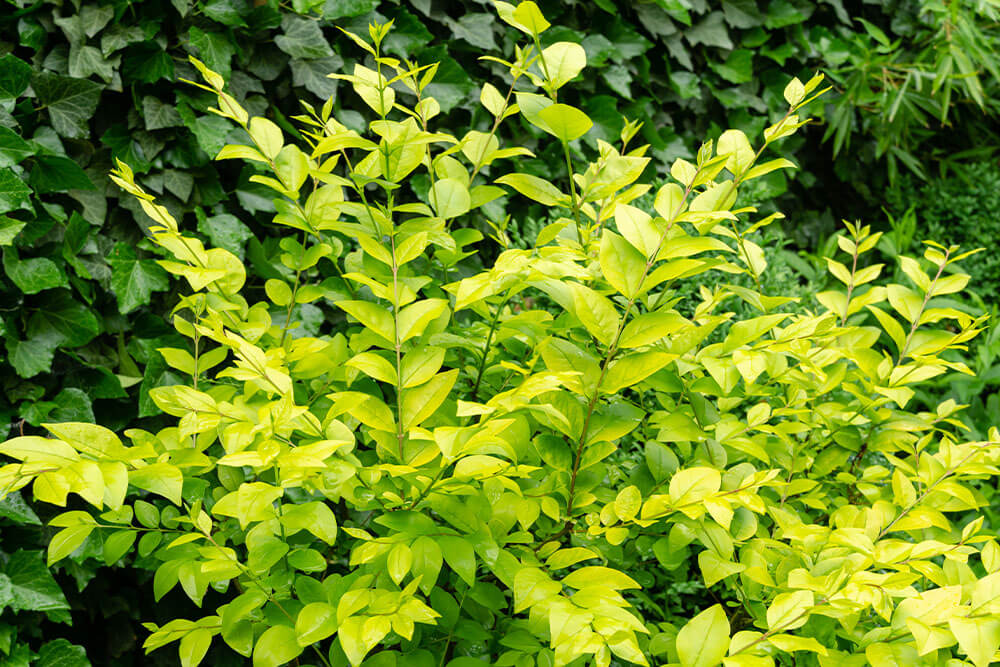
Privets have been — and continue to be — widely used in hedges all over the country. Unfortunately, almost every commonly planted species is invasive, in some cases quite aggressively so, and they really shouldn’t be planted in most gardens. However, the hybrid ‘Vicaryi’ privet is not invasive, and shares plenty of good qualities with its better-known relatives, with a unique twist: its foliage is bright yellow, a striking contrast against the rich greens of most hedge shrubs.
Its growth rate, while not quite as high as Chinese or Japanese privets, is well above average, and its hardiness — between zones 5 and 9 — is comparable as well. If you don’t like pruning, golden privet might be for you: not only does it maintain its shape without pruning, but excessive shearing actually causes less colorful foliage — so let these shrubs grow as nature intended!
15. Scarlet Firethorn (Pyracantha coccinea)
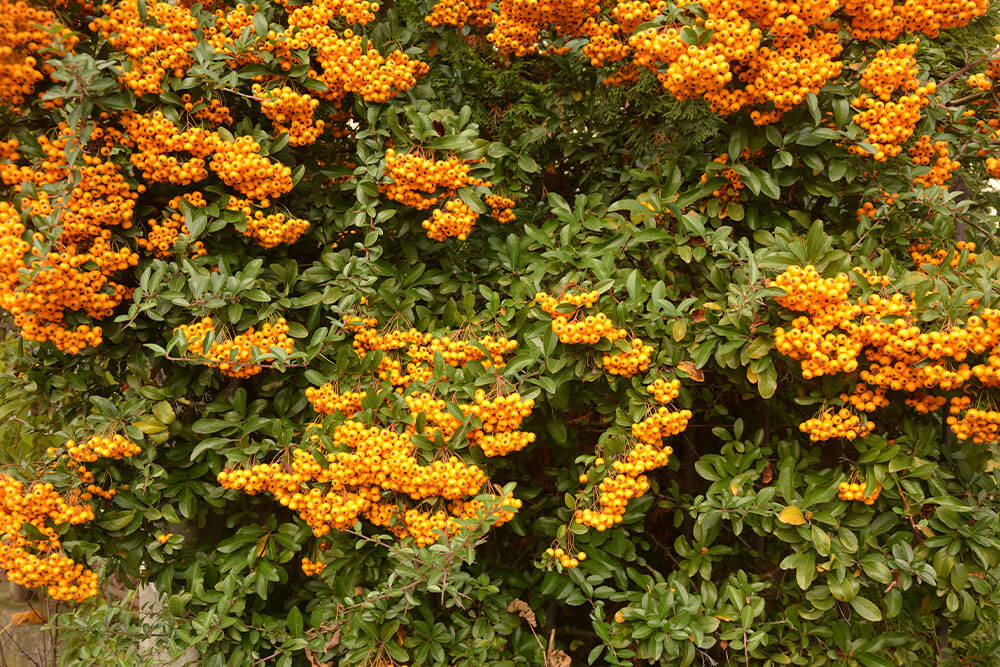
A firethorn hedge provides not just privacy but security: its sense growth and heavily armed stems are as good as razor wire for keeping out uninvited guests. It’s much prettier than razor wire, though, sporting generous white flowers in spring that ripen to equally lovely berry-like fruits in fall — and shiny evergreen foliage year-round (at least in zones 8 and above — firethorn is hardy to zone 5, but may lose some or even all its leaves in harsh winters).
It’s also a highly trainable shrub, and takes well to pruning: it’s often espaliered into amazing shapes and can even be used for topiary. That said, the namesake thorns can make pruning a hazardous pastime — consider using power tools on this one!
15 Fast-Growing Shrubs to Foil (and Delight) Nosy Neighbors
Hopefully, by the time you’re reading this, you’ll have found a shrub or two – or maybe more – that will be just right for your privacy screen. If not, though, don’t fret: these 15 shrubs are far from your only choices for an (almost) instant evergreen hedge.
Some, like yews and azaleas, aren’t lightning-fast, but using larger specimens can cut down on the time needed for them to “fill out.” If you’re willing to use deciduous or perennial shrubs, your options are even more diverse: from forsythia to weigela, there are dozens of vigorous shrubs that are perfect for hedges. You can even use grasses like bamboo or switchgrass!
As always, diversity is the spice of life: a combination of all of these – shrubs and perennials, deciduous and evergreen, etc. – will not only look fabulous, but be much more resilient to pests, diseases, and other disasters than a single-species hedge. Incorporating native species does the same thing, and has the added benefit of attracting native pollinators and wildlife.
Just remember to think of a privacy hedge just like any other garden planting: dream big, get creative, and don’t be afraid to experiment. With the right choice of plants, you’ll be enjoying your privacy sooner than you ever imagined – and your neighbors will be enjoying your horticultural masterpiece!
[wp-faq-schema title=”Frequently Asked Questions About Fast Growing Shrubs” accordion=1]

